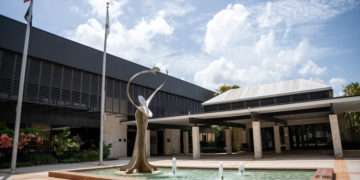 Dr. Tom Smythe is a professor of finance in the Lutgert College of Business at Florida Gulf Coast University.
Dr. Tom Smythe is a professor of finance in the Lutgert College of Business at Florida Gulf Coast University.
Whenever I talk about interest rates today, the first question I get is whether rates will rise. The answer is yes, I just don’t know when—although I will qualify this later.
Anyone who has taken an economics course bought a car or bought a house understands that interest rates are the “price” for using money. Interest rates compensate lenders for time value of money—the idea that a dollar is worth more today than a dollar tomorrow—and the risk I (or a company) present to the lender of not being able to repay the loan. Rates go up and down, in part, as people demand more or less money. This is the basic law of supply and demand.
It is because we “demand money today” that the Federal Reserve uses interest rates (as opposed to other tools) to nudge the economy one way or another; however, they operate on the supply side. For four decades, the Fed has used the Fed Funds market as its primary mechanism to affect credit. The Fed Funds Rate is not set by the Fed; it is a market rate for banks to borrow from one another for very short periods. The Fed targets this rate because 1) it is market-based and 2) the credit process flows through the banking system. If the Fed is concerned about economic growth slowing, they take actions to lower the rate. The hope is that banks will also lower rates they charge customers, and if the supply/demand model works, people are more apt to borrow, leading to increased spending and investment and, ultimately, economic growth.
So, what is happening now? The Fed has navigated the Fed Funds Rate to almost zero. (“Normal” is about 4 percent.) The Fed wants to facilitate putting money into the system to stimulate spending and investment, but the focus on rates has largely lost its “wow” factor—in large part because rates have been close to zero since 2008, averaging just 0.6 percent since that time. In short, the Fed did not have much room to move, but that is not the only issue with the Fed’s efforts to fight the current situation.
People and firms must also be willing to borrow. Two factors have an impact on this today: First, people who could borrow have done so at low rates over the last decade, and as we are seeing now, some borrowed too much of the cheap money. Secondly, people are fearful about the future and until the uncertainty is resolved, people will be reluctant to spend, meaning they are less likely to take advantage of lower rates.
Finally, banks must also be willing to lend. Unlike in the past, bank rates—especially mortgage rates—have been slow to fall. One reason is technical; when the Fed lowered rates in March, people assumed mortgage rates would follow and rushed to refinance homes. The problem is that bank staff was overwhelmed. To limit demand, banks have kept mortgage rates higher than they might be otherwise. However, another factor is coming into play, as well. As rates approach zero, banks have a difficult time being compensated for borrower risk. As such, banks are more reluctant to lend.
So, rates will go up, and while I do not know exactly when, it will likely not be for at least a year. Financial markets are betting the Fed will keep rates close to zero until at least June 2021. Any upward moves will likely be small until the economy stabilizes. Rates to consumers may drop, but the reality is that they have little room to fall.





